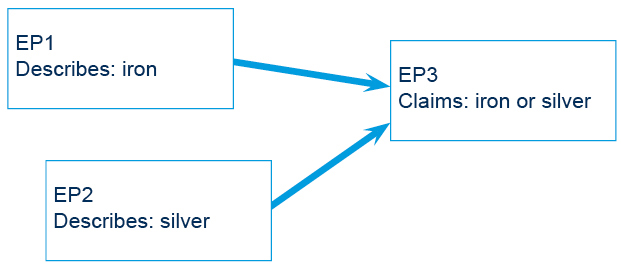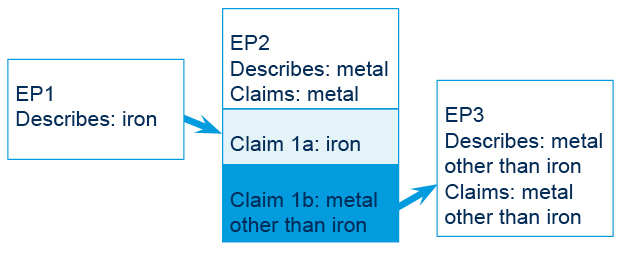G 1/15 resolves question of poisonous priorities
The Board of Appeal have now released their written decision in respect of case G1/15 (appeal number T0557/13).
Background
This case concerns the issue of so-called "poisonous priorities" where an applicant's own priority application is used against a subsequent patent application. For example, consider the simple case in which a first priority application (EP1) is filed relating to the subject matter of "iron". A subsequent application (EP2) is filed by the same applicant within 12 months for the subject matter of "metal".

In this case, priority for the claim of "metal" is not permitted because only "iron" and not the broader concept of "metal" was disclosed in EP1. Consequently, EP1 becomes Article 54(3) EPC prior art against EP2 and will deprive EP2 of novelty.
Partial priority
G2/98 allows the idea of partial priority in which a single claim could have multiple priorities for different subject matter encompassed by that claim. For example, if a first application (EP1) discloses iron (as above), and a second application (EP2) discloses silver, then a third application (EP3), claiming priority to both and claiming "iron or silver" will be treated as two different claim objects. The first will be to "iron" and will have a priority date of EP1 and the other will be to "silver" and will have a priority date of EP2.

But what about in the first example, where the later application claims a broader concept rather than a number of distinct alternatives? G2/98 states that the claim still has multiple priorities "provided that it gives rise to the claiming of a limited number of clearly defined alternative subject matters".
But herein lies the problem. What exactly does this mean? And what happens if it is not met? Consider the first example again.

Can it be said that the subject matters "iron" and "metal except iron" are clearly defined? Are these alternative subject matters? If not, does partial priority still apply to EP2? If not, is any priority claim possible? If not, doesn't that disadvantage an applicant that continues to work on their invention after filing an initial application (a common approach)?
Decision
In G1/15, the Board of Appeal ruled that "Under the EPC, entitlement to partial priority may not be refused for a claim encompassing alternative subject-matter by virtue of one or more generic expressions or otherwise (generic 'OR'-claim) provided that said alternative subject-matter has been disclosed for the first time, directly, or at least implicitly, unambiguously and in an enabling manner in the priority document. No other substantive conditions or limitations apply in this respect" (page 45 of the decision).
Reasoning
As noted by the Board of Appeal (point 4.1), priority is a right, as set out in both the EPC and the Paris Convention, which governs the concept of priority. Furthermore, as a matter of principle (point 4.2), a right established by a treaty, convention, or national law cannot be restricted by imposing supplementary conditions.
Consequently, priority must be given if the requirements laid out in the Paris Convention are met, and further conditions cannot be added.
Also as noted (point 4.3.5), Article 4B of the Paris Convention establishes that "Any subsequent filing ... shall not be invalidated by reason of any acts accomplished in the interval".
Consequently (point 4.4), priority operates to exclude the collision of subject-matter disclosed in the priority period with identical subject matter disclosed in a priority document (to the extent that priority is validly claimed).
Interpretation
As explained in point 6.4 of the decision, subject matter that is disclosed in the priority application(s) is entitled to a priority date according to the document that first disclosed that subject matter. For everything else, no priority date is awarded, but the application may itself form the basis of a priority claim.
Taking the above example, then, involving EP1 and EP2, EP2 would be conceptually split into two parts: one part relating to "iron" (the material that was disclosed in the priority application) and "metal that is not iron" (everything else). The first part is entitled to priority, while the second part is not. However, a further application could use EP2 as an application from which priority to the idea of "metal that is not iron" is claimed.
There is no requirement that either EP1 or EP2 explicitly even mentions the concept of "metal that is not iron", since such a requirement would appear to violate the right to priority accorded by the Paris Convention, by adding supplementary requirements in order for priority to be claimed. Hence, even though there is no basis for the generalisation of "metal that is not iron", this does not affect any claim to priority.

Conclusions
It appears that G1/15 has resolved the question of poisonous priorities (and poisonous divisionals) once and for all.
Since G1/15 allows a conceptual splitting of subject matter (for the purposes of claiming priority) without requiring explicit basis, this may remove the burden for the applicant to anticipate future developments, or to insert explicit basis for exclusions when filing a subsequent application in Europe that broadens an invention.
Of course, the same may not be true of other jurisdictions. Given that providing explicit basis for exclusions in a broader claiming application is unlikely to do any harm, it may be advisable to continue to do so.
